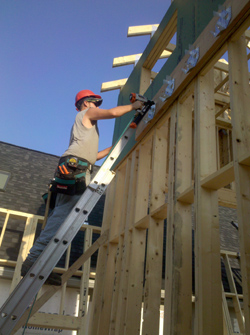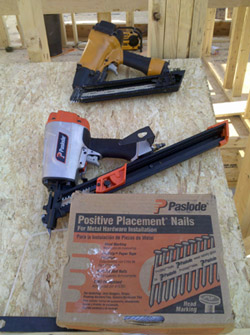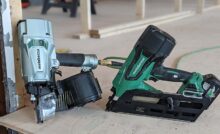Paslode PF150S-PP Review
PF150S-PP Positive Placement® Metal Connector Nailer


Engineered Lumber Projects – The Game Has Changed
Over the last 10 years the entire wood framing industry has changed significantly with the increased specification and use of engineered lumber products. Along with all of the versatile new engineered lumber are literally hundreds of metal connector / hanger plates for connecting the new lumber products.


Positive Placement nailers have revolutionized both productivity and quality installation of engineered metal connectors and fasteners. Positive placement nailers allow the user to accurately align the fastener with the holes in the metal connector. The result is quick and accurate installation without wear and tear on the carpenter.
Paslode PF150S-PP Features
- Durable and powerful for tough jobsite conditions
- Lightweight, compact design fits in tight spaces
- 2-strip magazine – high capacity, less reloading
- Non-slip cushioned grip provides comfort and control
- Probing tip locates nail hole quickly – work faster
- Shoots 1-1/2 inch long connector nails in 0.131 or 0.148 inch diameters covering most code requirements
Paslode PF150S-PP Review


There are two major features to this positive placement nailers that set it apart from some of the other guys we’ve seen and used.
- Longer magazine which carries two strips of nails (the other nailers we use only holds one strip).
- The probing tip makes nail alignment quicker and safer.
Nail Capacity
One of the biggest “cons” to our previous positive placement nailers was the short magazine that would only hold one strip of nails. A strip usually holds about 20 nails and an average joist hanger can require 10 to 15 nails or more! So this results in lots of lost time re-loading the nailer.


Probing Tip
The other feature that we really like is the probing tip. The probing tip is another difference over the competition that really improves the speed of nail installation. We just felt that the tip really ensure that the fastener will hit the hole more often compared to models that just use the fastener as the probe.
Overall Thoughts
The Paslode PF150S-PP has some great new features that we think push it to the top of the class when it comes to positive placement nailers.
While the nailer weighs in about 2 lbs heavier than it’s competitor it’s still only just over 6 lbs which is light for a “framing” type nailer.
The longer nail magazine is a huge productivity booster in our opinion and the feature that’s likely to convince many other builders to consider it. In addition we felt the PF150S-PP was just as powerful as the competition, well built and well balanced. For that reason we highly recommend the Paslode PF150S-PP positive placement nailer.
Recent Posts
Framing Stick Nailer vs Coil Nailer
Which is Better a Stick Nailer or Coil Nailer? Framers have many choices in nailers…
How Many Roofing Nails Per Square of Shingles
Estimating How Many Nails for a New Roof When it comes to estimating materials for…
Composite / PVC Decking – Layout Tips & Advice
Composite / PVC Decking Layout Tips and Advice Composite and PVC decking have really changed…
Benefits of an ERV System (Energy Recovery Ventilator)
Benefits of ERV Systems (Energy Recovery Ventilator) If you're building a new home or doing…
Vermiculite Attic Insulation Abatement
Vermiculite Attic Insulation If your home was built before 1990 there is a chance it…
Nuisance Tripping of AFCI (Arc Fault) Circuit Breakers
Arc Fault (AFCI) Circuit Breakers Tripping Often An arc-fault circuit interrupter (AFCI) or arc-fault detection…

View Comments
Todd,
As always, great review.
I'm curious about the positive placement -probing tip.
I've always been interested in these type of guns but was unsure what happens if you miss the hole. Will the nail penetrate the hanger r does it not fire or curl back?
ROB
Rob - Great question. I'll check with the guys but I'm almost certain it shoots through the plate. We were talking today about whether we could shoot some strapping over the hanger (through the hanger) and the guys indicated it shouldn't be a problem. The probe makes it VERY easy to hit the holes though.
thanks - look forward to hearing from them
Rob - I was just at the job site....they showed me what happens when you miss the hole.....shoots right through it!! No problem. The guys said it's pretty hard to miss as the probe really catches the holes on the hangers.